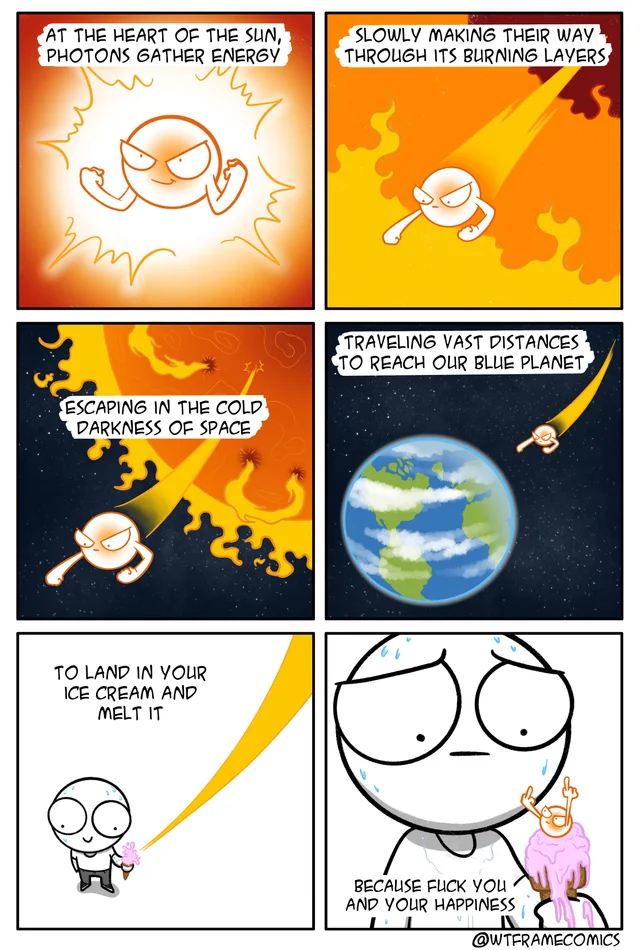this post was submitted on 11 Jan 2025
661 points (97.7% liked)
Science Memes
11566 readers
2106 users here now
Welcome to c/science_memes @ Mander.xyz!
A place for majestic STEMLORD peacocking, as well as memes about the realities of working in a lab.

Rules
- Don't throw mud. Behave like an intellectual and remember the human.
- Keep it rooted (on topic).
- No spam.
- Infographics welcome, get schooled.
This is a science community. We use the Dawkins definition of meme.
Research Committee
Other Mander Communities
Science and Research
Biology and Life Sciences
- !abiogenesis@mander.xyz
- !animal-behavior@mander.xyz
- !anthropology@mander.xyz
- !arachnology@mander.xyz
- !balconygardening@slrpnk.net
- !biodiversity@mander.xyz
- !biology@mander.xyz
- !biophysics@mander.xyz
- !botany@mander.xyz
- !ecology@mander.xyz
- !entomology@mander.xyz
- !fermentation@mander.xyz
- !herpetology@mander.xyz
- !houseplants@mander.xyz
- !medicine@mander.xyz
- !microscopy@mander.xyz
- !mycology@mander.xyz
- !nudibranchs@mander.xyz
- !nutrition@mander.xyz
- !palaeoecology@mander.xyz
- !palaeontology@mander.xyz
- !photosynthesis@mander.xyz
- !plantid@mander.xyz
- !plants@mander.xyz
- !reptiles and amphibians@mander.xyz
Physical Sciences
- !astronomy@mander.xyz
- !chemistry@mander.xyz
- !earthscience@mander.xyz
- !geography@mander.xyz
- !geospatial@mander.xyz
- !nuclear@mander.xyz
- !physics@mander.xyz
- !quantum-computing@mander.xyz
- !spectroscopy@mander.xyz
Humanities and Social Sciences
Practical and Applied Sciences
- !exercise-and sports-science@mander.xyz
- !gardening@mander.xyz
- !self sufficiency@mander.xyz
- !soilscience@slrpnk.net
- !terrariums@mander.xyz
- !timelapse@mander.xyz
Memes
Miscellaneous
founded 2 years ago
MODERATORS
you are viewing a single comment's thread
view the rest of the comments
view the rest of the comments

It is not direct sunlight that is melting your ice mate. Let's say the scoop has 10 cm² getting blasted from the sun, that's 1 Watt of heat under maximum possible conditions (Sun vertically above you, perfectly black ice, etc.). tl;dr: In total from convenction 1.8 W, condensation 2.5 W and radiation 0.65 W = 4.95 W -> maximum possible sunlight on earth would only increase this by 20 %, more realistic sunlight something like 10 %.
Actual math: Compare that to ambient temperatures of say, 30 °C, and let's again say 10 cm² cross section, which translates to a diameter of 3.57 cm, so a sphere with a surface of 40 cm². The heat transfer coefficient under normal conditions is about 15 W/(m²K), so we get: 15 W/(m²K) * 0.004 m² * 30 K = 1.8 W
Additionally, we have latent heat from water (humidity) condensing on the cold surface: Let's assume a Schmidt number of 0.6, so we get a mass transfer coefficient of: 15 W/(m²K) / [1.2 kg/m³ * 1000 J/(kgK)] * 0.6^(-2/3) = 0.0176 m/s Specific gas constant: 8.314 J/(molK) / 0.018 kg/mol = 462 J/(kgK) So the mass flux (condensation speed) is: 0.0176 m/s * 2000 Pa / [462 J/(kgK) * 273 K] = 0.00038 kg/(m²s)
Given the heat of condensation of 2257 kJ/kg water we thus get: 0.00038 kg/(m²*s) * 2257000 J/kg = 632 W/m²
And thus for our little sphere: 632 W/m² * 0.004 m² = 2.5 W
... Then we also have radiation from the hot surrounding, let's assume 30 °C again, we get: Q = 5.67E-8 W/(m²*K^4) * 0.004 m² * (303 K^4 - 273 K^4) = 0.65 W (omitting radiation from the sky)
So made this meme is eating ice cream when it's below or near freezing? Because you still get ice melting below freezing due to radiation.
Yes, while the radiation puts more energy in than the convective etc. cooling removes. So near 0 this is guaranteed, since the temperature difference from ice to ambient is almost 0 while radiation keeps pumping in something like 0.5 W. But who eats ice at freezing temperatures... And outside?
I have eaten ice cream outside when temperatures were sub-zero Fahrenheit. It's not something I do regularly but it's happened and will probably happen again.
If I want ice cream, then I want ice cream. No other considerations matter.